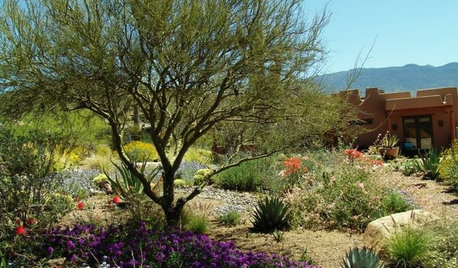How to Switch From Lawn to Xeriscape?
humster
17 years ago
Related Stories

GARDENING GUIDESHow to Switch to an Organic Landscape Plan
Ditch the chemicals for a naturally beautiful lawn and garden, using living fertilizers and other nontoxic treatments
Full Story
SAVING WATERXeriscape Gardens: How to Get a Beautiful Landscape With Less Water
Conserve water and make gardening much easier with the xeriscape approach’s 7 principles
Full Story
GREAT HOME PROJECTSHow to Replace Your Lawn With a Garden
New project for a new year: Lose the turfgrass for energy savings, wildlife friendliness and lower maintenance
Full Story
DESIGN DICTIONARYXeriscape
Drought-tolerant plants and efficient irrigation form the heart of ecofriendly xeriscape landscaping
Full Story0

LANDSCAPE DESIGN7 Low-Maintenance Lawn Alternatives
Turf isn't the only ground cover in town. Get a lush no-grass lawn with clover, moss and other easy-care plants
Full Story
FRONT YARD IDEASBefore and After: Front Lawn to Prairie Garden
How they did it: Homeowners create a plan, stick to it and keep the neighbors (and wildlife) in mind
Full Story
SAVING WATERHouzz Call: Are You Letting Go of Your Lawn?
Many facing a drought are swapping turf for less thirsty plantings. If you’re one of them, we’d like to hear about it
Full Story
LANDSCAPE DESIGNCalifornia Says Goodbye to the Sprawling Ornamental Lawn
New state rules will effectively limit turfgrass to 25 percent of the landscape in most new and renovated yards
Full Story
MOST POPULARMeet a Lawn Alternative That Works Wonders
Carex can replace turfgrass in any spot, is low maintenance and adjusts easily. Add its good looks and you’ve got a ground cover winner
Full Story
BEFORE AND AFTERSSee 6 Yards Transformed by Losing Their Lawns
Wondering whether a turf lawn is the best use of your outdoor space? These homeowners did, and they found creative alternatives
Full StorySponsored






abq_bob
humsterOriginal Author
Related Professionals
Milwaukee Landscape Architects & Landscape Designers · Mitchellville Landscape Architects & Landscape Designers · South Elgin Landscape Architects & Landscape Designers · Wake Forest Landscape Contractors · Alpharetta Landscape Contractors · Battle Ground Landscape Contractors · Columbine Landscape Contractors · Cudahy Landscape Contractors · East Patchogue Landscape Contractors · Florham Park Landscape Contractors · Mahwah Landscape Contractors · Pleasanton Landscape Contractors · West Orange Landscape Contractors · Whitehall Landscape Contractors · Springdale HandymanhumsterOriginal Author
bungalowbees
humsterOriginal Author
humsterOriginal Author
jrod
laughingearth
marilyn8620